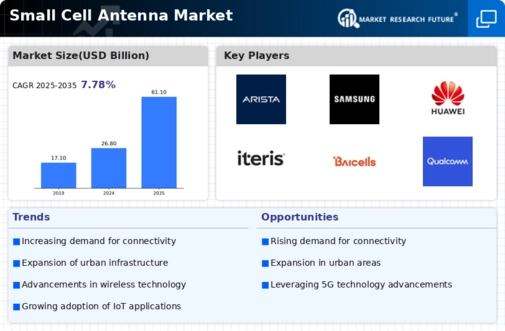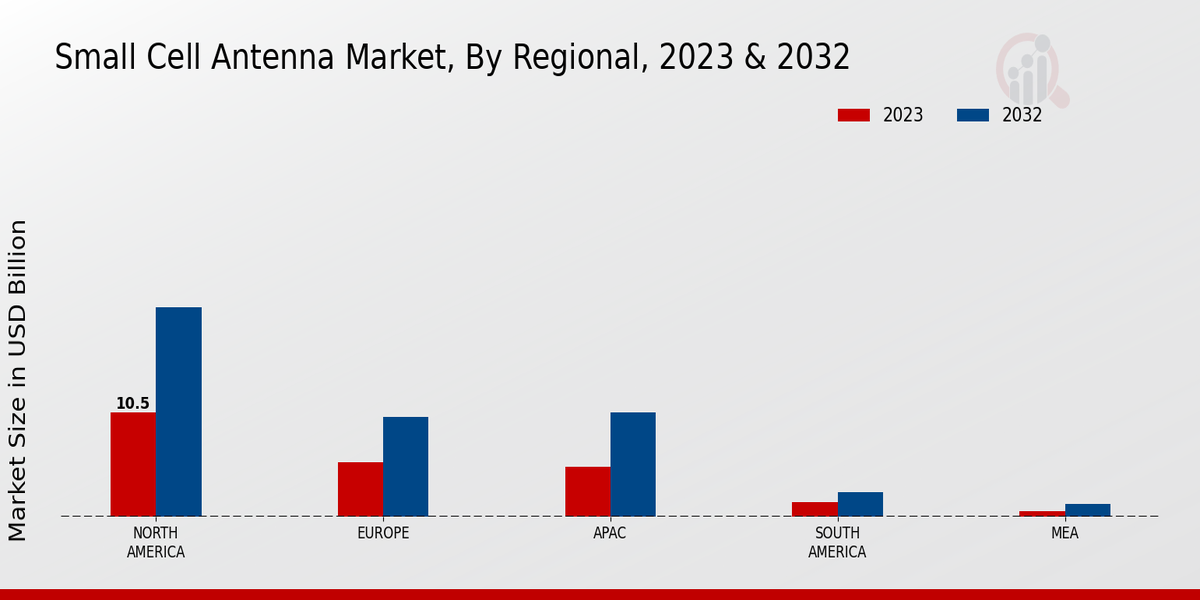Market Growth Projections
The Global Small Cell Antenna Market Industry is projected to experience substantial growth over the next decade. With a market value expected to reach 26.8 USD Billion in 2024 and 61.1 USD Billion by 2035, the industry is on a robust upward trajectory. The anticipated CAGR of 7.78% from 2025 to 2035 indicates a sustained demand for small cell technology, driven by factors such as urbanization, the expansion of 5G networks, and the proliferation of IoT devices. This growth presents opportunities for stakeholders across the telecommunications sector, including manufacturers, service providers, and investors, to capitalize on the increasing need for enhanced connectivity solutions.
Support for 5G Network Expansion
The Global Small Cell Antenna Market Industry is significantly influenced by the ongoing expansion of 5G networks. As telecommunications companies invest heavily in 5G infrastructure, small cell antennas play a pivotal role in facilitating this transition. These antennas are essential for providing the high-frequency coverage required for 5G technology, particularly in urban areas where signal penetration is challenging. The anticipated growth of the market to 61.1 USD Billion by 2035 underscores the critical role of small cells in supporting the next generation of mobile communication. This expansion is likely to enhance user experiences and enable innovative applications across various sectors.
Increased Adoption of IoT Devices
The Global Small Cell Antenna Market Industry is witnessing increased adoption of Internet of Things (IoT) devices, which necessitates improved network infrastructure. As more devices connect to the internet, the demand for reliable and high-capacity networks intensifies. Small cell antennas are well-suited to support the growing number of IoT applications, from smart cities to industrial automation. This trend indicates a shift towards more interconnected systems, where small cells can enhance data transmission and reduce latency. The market's growth trajectory, with a projected CAGR of 7.78% from 2025 to 2035, reflects the increasing reliance on small cells to accommodate the expanding IoT ecosystem.
Government Initiatives and Funding
The Global Small Cell Antenna Market Industry benefits from various government initiatives aimed at improving telecommunications infrastructure. Many governments recognize the importance of robust connectivity for economic growth and social development. Funding programs and policy frameworks are being established to encourage the deployment of small cell technology, particularly in underserved areas. This support is crucial for enhancing digital inclusion and ensuring that all communities have access to reliable internet services. As a result, the market is poised for growth, with government backing likely to accelerate the adoption of small cell antennas across different regions.
Growing Demand for Enhanced Connectivity
The Global Small Cell Antenna Market Industry experiences a surge in demand for enhanced connectivity, driven by the proliferation of mobile devices and the increasing reliance on high-speed internet. As urban areas become densely populated, traditional macro cell towers struggle to provide adequate coverage. Small cell antennas offer a solution by improving network capacity and coverage in localized areas. This trend is evident as the market is projected to reach 26.8 USD Billion in 2024, reflecting the urgent need for robust communication infrastructure. The deployment of small cells in urban environments is crucial for meeting the connectivity demands of consumers and businesses alike.
Technological Advancements in Antenna Design
The Global Small Cell Antenna Market Industry is propelled by technological advancements in antenna design and materials. Innovations such as beamforming and MIMO (Multiple Input Multiple Output) technology enhance the performance of small cell antennas, allowing for better signal quality and increased capacity. These advancements enable operators to optimize their networks and provide superior service to users. As the market evolves, manufacturers are focusing on developing compact and efficient designs that can be easily integrated into existing infrastructure. This focus on innovation is expected to drive market growth, as operators seek to leverage cutting-edge technology to meet the demands of modern communication.















